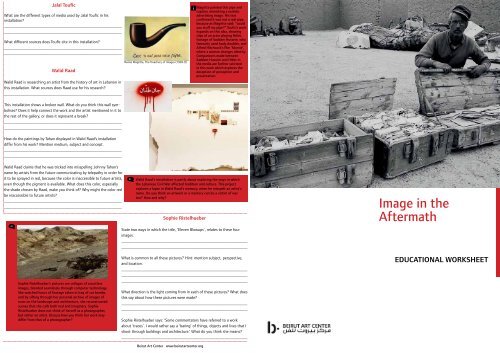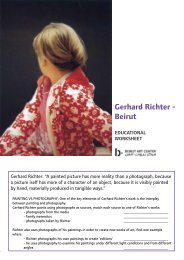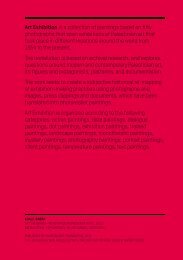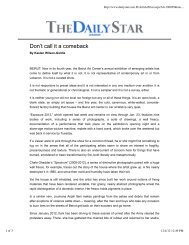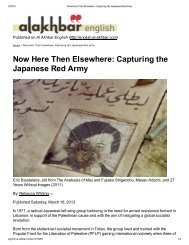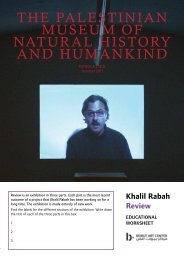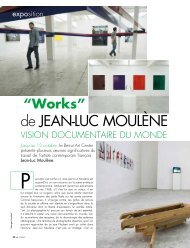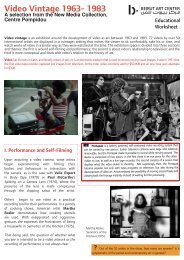Image in the Aftermath - Beirut Art Center
Image in the Aftermath - Beirut Art Center
Image in the Aftermath - Beirut Art Center
Create successful ePaper yourself
Turn your PDF publications into a flip-book with our unique Google optimized e-Paper software.
Jalal Toufic<br />
What are <strong>the</strong> different types of media used by Jalal Toufic <strong>in</strong> his<br />
<strong>in</strong>stallation<br />
________________________________________________________<br />
________________________________________________________<br />
What different sources does Toufic cite <strong>in</strong> this <strong>in</strong>stallation<br />
________________________________________________________<br />
________________________________________________________<br />
Walid Raad<br />
Walid Raad is research<strong>in</strong>g an artist from <strong>the</strong> history of art <strong>in</strong> Lebanon <strong>in</strong><br />
this <strong>in</strong>stallation. What sources does Raad use for his research<br />
________________________________________________________<br />
Renée Magritte, The Treachery of <strong>Image</strong>s (1928- 9)<br />
i<br />
Magritte pa<strong>in</strong>ted this pipe and<br />
caption, mimick<strong>in</strong>g a realistic<br />
advertis<strong>in</strong>g image. His text<br />
confirmed it was not a real pipe,<br />
because as Magritte said: “could<br />
you stuff my pipe” Toufic’s work<br />
expands on this idea, show<strong>in</strong>g<br />
clips of an actor play<strong>in</strong>g Hitler,<br />
footage of Saddam Husse<strong>in</strong>, who<br />
famously used body doubles, and<br />
Alfred Hitchcock’s film ‘Marnie’,<br />
where a woman changes identity.<br />
Comparisons made between<br />
Saddam Husse<strong>in</strong> and Hitler <strong>in</strong><br />
<strong>the</strong> media are fur<strong>the</strong>r satirized<br />
<strong>in</strong> this work which explores <strong>the</strong><br />
deception of perception and<br />
presentation.<br />
This <strong>in</strong>stallation shows a broken wall. What do you th<strong>in</strong>k this wall symbolises<br />
Does it help connect <strong>the</strong> work and <strong>the</strong> artist mentioned <strong>in</strong> it to<br />
<strong>the</strong> rest of <strong>the</strong> gallery, or does it represent a break<br />
________________________________________________________<br />
________________________________________________________<br />
How do <strong>the</strong> pa<strong>in</strong>t<strong>in</strong>gs by Tahan displayed <strong>in</strong> Walid Raad’s <strong>in</strong>stallation<br />
differ from his work Mention medium, subject and concept.<br />
________________________________________________________<br />
________________________________________________________<br />
Walid Raad claims that he was tricked <strong>in</strong>to misspell<strong>in</strong>g Johnny Tahan’s<br />
name by artists from <strong>the</strong> future communicat<strong>in</strong>g by telepathy <strong>in</strong> order for<br />
it to be sprayed <strong>in</strong> red, because <strong>the</strong> color is <strong>in</strong>accessible to future artists,<br />
even though <strong>the</strong> pigment is available. What does this color, especially<br />
<strong>the</strong> shade chosen by Raad, make you th<strong>in</strong>k of Why might <strong>the</strong> color red<br />
be <strong>in</strong>accessible to future artists<br />
________________________________________________________<br />
________________________________________________________<br />
d. t.<br />
d. t.<br />
Walid Raad‘s <strong>in</strong>stallation is partly about explor<strong>in</strong>g <strong>the</strong> ways <strong>in</strong> which<br />
<strong>the</strong> Lebanese Civil War affected tradition and culture. This project<br />
explores a lapse <strong>in</strong> Walid Raad‘s memory, when he misspelt an artist‘s<br />
name. Do you th<strong>in</strong>k an artwork or a memory can be a victim of war<br />
too How and why<br />
Sophie Ristelhueber<br />
State two ways <strong>in</strong> which <strong>the</strong> title, ‘Eleven Blowups’, relates to <strong>the</strong>se four<br />
images.<br />
____________________________________________________________<br />
____________________________________________________________<br />
<strong>Image</strong> <strong>in</strong> <strong>the</strong><br />
<strong>Aftermath</strong><br />
Sophie Ristelhueber’s pictures are collages of countless<br />
images, blended seamlessly through computer technology.<br />
She watched hours of footage taken <strong>in</strong> Iraq of car bombs,<br />
and by sift<strong>in</strong>g through her personal archive of images of<br />
scars on <strong>the</strong> landscape and architecture, she reconstructed<br />
scenes that she calls both real and imag<strong>in</strong>ary. Sophie<br />
Ristelhueber does not th<strong>in</strong>k of herself as a photographer,<br />
but ra<strong>the</strong>r an artist. Discuss how you th<strong>in</strong>k her work may<br />
differ from that of a photographer<br />
What is common to all <strong>the</strong>se pictures H<strong>in</strong>t: mention subject, perspective,<br />
and location.<br />
____________________________________________________________<br />
____________________________________________________________<br />
____________________________________________________________<br />
What direction is <strong>the</strong> light com<strong>in</strong>g from <strong>in</strong> each of <strong>the</strong>se pictures What does<br />
this say about how <strong>the</strong>se pictures were made<br />
____________________________________________________________<br />
____________________________________________________________<br />
Sophie Ristelhueber says: ‘Some commentators have referred to a work<br />
about ‘traces’. I would ra<strong>the</strong>r say a ‘bar<strong>in</strong>g’ of th<strong>in</strong>gs, objects and lives that I<br />
shoot through build<strong>in</strong>gs and architecture.’ What do you th<strong>in</strong>k she means<br />
____________________________________________________________<br />
<strong>Beirut</strong> <strong>Art</strong> <strong>Center</strong> www.beirutartcenter.org<br />
educational worksheet
This exhibition, <strong>Image</strong> <strong>in</strong> <strong>the</strong> <strong>Aftermath</strong>, is about artists from all over <strong>the</strong> world who use<br />
different techniques to respond to historical events. On <strong>the</strong> right is <strong>the</strong> floor plan of <strong>the</strong><br />
exhibition space. Locate <strong>the</strong>se 5 numbered works on <strong>the</strong> map.<br />
1<br />
Facts about Western Sahara:<br />
- Western Sahara was a Spanish colony<br />
until 1975<br />
- Morocco and Mauritania <strong>in</strong>vaded<br />
when Spa<strong>in</strong> withdrew.<br />
- Mauritania withdrew <strong>in</strong> 1979, but <strong>the</strong><br />
conflict cont<strong>in</strong>ued with Morocco.<br />
- A ceasefire was announced <strong>in</strong> 1991<br />
but more than 200,000 Sahrawis rema<strong>in</strong><br />
<strong>in</strong> refugee camps <strong>in</strong> Algeria.<br />
- The media has largely ignored<br />
<strong>the</strong> conflict, but <strong>the</strong> Sahrawis have<br />
documented it, creat<strong>in</strong>g a War Museum<br />
that archives <strong>the</strong>ir struggle.<br />
Sahara Occidentale, con poche immag<strong>in</strong>i<br />
(Western Sahara, few images)<br />
What is different about <strong>the</strong> doors of this <strong>in</strong>stallation<br />
What effect does it give<br />
_____________________________________________<br />
_____________________________________________<br />
What is surpris<strong>in</strong>g about <strong>the</strong> way cameras are used <strong>in</strong> this<br />
<strong>in</strong>stallation<br />
_____________________________________________<br />
Masao Okabe and Chihiro M<strong>in</strong>ato<br />
In this white box, use Masao Okabe’s rubb<strong>in</strong>g technique to<br />
transfer <strong>the</strong> texture of a surface with a pencil.<br />
2<br />
3<br />
d. t.<br />
The Sahrawi War Museum<br />
<strong>in</strong>cludes photographs found<br />
on killed or captured Moroccan<br />
enemy soldiers, which <strong>the</strong>y<br />
hope to return to <strong>the</strong>ir families<br />
one day. How does this differ<br />
from <strong>the</strong> way war and enemies<br />
are documented <strong>in</strong> <strong>the</strong> news<br />
and <strong>in</strong> films<br />
What are <strong>the</strong> different types of image displayed<br />
_____________________________________________<br />
What is <strong>the</strong> difference between <strong>the</strong>se images and footage<br />
and what you see on <strong>the</strong> news and <strong>in</strong> newspapers<br />
_____________________________________________<br />
_____________________________________________<br />
Masao Okabe uses his rubb<strong>in</strong>g technique to capture <strong>the</strong> texture of this site <strong>in</strong> Hiroshima as<br />
a remembrance to <strong>the</strong> scars of history it reta<strong>in</strong>s.<br />
Watch Masao Okabe and Chihiro M<strong>in</strong>ato’s video and<br />
match <strong>the</strong> dates mentioned to <strong>the</strong> historical events:<br />
4<br />
Write <strong>the</strong> titles and dates of <strong>the</strong>se numbered works:<br />
F<strong>in</strong>d <strong>the</strong> photographs <strong>the</strong> Sahrawis have taken of <strong>the</strong>ir<br />
own bodies. Why do you th<strong>in</strong>k <strong>the</strong>y photograph <strong>the</strong>ir<br />
own bodies<br />
_____________________________________________<br />
_____________________________________________<br />
a<br />
b<br />
1894<br />
1945<br />
1<br />
2<br />
The earthquake <strong>in</strong> Japan and radioactive<br />
spill from Fukushima Nuclear Power Plant<br />
The year <strong>the</strong> station <strong>in</strong> Uj<strong>in</strong>a was built<br />
5<br />
1 _________________________________________<br />
2 _________________________________________<br />
3 _________________________________________<br />
What is shown <strong>in</strong> this image<br />
_____________________________________________<br />
180 Seconds of Last<strong>in</strong>g <strong>Image</strong>s<br />
c<br />
d<br />
2001<br />
2011<br />
3<br />
4<br />
The year <strong>the</strong> United States dropped an<br />
Atomic Bomb on Hiroshima<br />
The date of <strong>the</strong> last rubb<strong>in</strong>g, which was<br />
<strong>in</strong>terrupted by <strong>the</strong> demolition of Uj<strong>in</strong>a<br />
station.<br />
<strong>Image</strong> <strong>in</strong> <strong>the</strong> <strong>Aftermath</strong><br />
The Nakba Archive<br />
Hiroshima & Nagasaki<br />
A-bombed by USA<br />
The creation of Israel<br />
- The Nakba<br />
F<strong>in</strong>d <strong>the</strong> historical events <strong>in</strong> <strong>the</strong> timel<strong>in</strong>e below that<br />
<strong>the</strong> follow<strong>in</strong>g artworks respond to and circle <strong>the</strong>m.<br />
- Sahara Occidentale, con poche immag<strong>in</strong>i<br />
- 180 Seconds of Last<strong>in</strong>g <strong>Image</strong>s<br />
- The Nakba Archive<br />
- The Dark Face of <strong>the</strong> Light<br />
Each of <strong>the</strong> artworks uses a different way to respond<br />
historical events. Name <strong>the</strong> artwork or artist that:<br />
Photographs destruction<br />
Exam<strong>in</strong>es physical traces<br />
Commemorates rema<strong>in</strong>s<br />
Is used as a tool of resistance<br />
Uses research to rediscover a tradition impacted by<br />
<strong>the</strong> effects of war<br />
Preserves <strong>the</strong> memory of a conflict that could be<br />
denied of forgotten<br />
Watch one of <strong>the</strong> videos <strong>in</strong> this room and list<br />
three memories you hear.<br />
_____________________________________<br />
_____________________________________<br />
_____________________________________<br />
_____________________________________<br />
Facts about <strong>the</strong> Nakba:<br />
- In 1948 Palest<strong>in</strong>ians were forced to leave <strong>the</strong>ir homes<br />
dur<strong>in</strong>g <strong>the</strong> war with Israel.<br />
- This period of Palest<strong>in</strong>ian history is called <strong>the</strong> Nakba,<br />
which means catastrophe <strong>in</strong> Arabic.<br />
- Many Palest<strong>in</strong>ians fled to Jordan, Lebanon and Syria.<br />
- In Lebanon, most were placed <strong>in</strong> refugee camps<br />
around <strong>the</strong> country, where <strong>the</strong>y still live 60 years later.<br />
- While any Jew liv<strong>in</strong>g <strong>in</strong> any country <strong>in</strong> <strong>the</strong> world can<br />
immigrate to Israel, Palest<strong>in</strong>ian refugees cannot return.<br />
Spanish Withdrawal<br />
and Moroccan/<br />
Mauritanian Invasion<br />
of Western Sahara<br />
Beg<strong>in</strong>n<strong>in</strong>g of<br />
Lebanese Civil War<br />
Withdrawal of<br />
Mauritania from<br />
Western Sahara<br />
1945 1950 1955 1960 1965 1970 1975 1980 1985 1989 1990 1991 1995 2000<br />
2005 2010<br />
2015<br />
Israeli <strong>in</strong>vasion of<br />
Lebanon<br />
i<br />
Why are <strong>the</strong> images so faded <strong>in</strong> this film<br />
___________________________________________________<br />
___________________________________________________<br />
Taif Agreement -<br />
beg<strong>in</strong>n<strong>in</strong>g of end of<br />
Civil War <strong>in</strong> Lebanon<br />
We th<strong>in</strong>k of film as seamless movement. In fact<br />
it is made up of a series of still images, each of<br />
which is called a frame.<br />
If <strong>the</strong>re are 180 seconds of film and 24 frames are shot per<br />
second, how many images are displayed<br />
180 x 24 = _ _ _ _<br />
First Gulf War<br />
Ceasefire <strong>in</strong> Western<br />
Sahara<br />
Invasion of Iraq<br />
The Assass<strong>in</strong>ation<br />
of Rafik Hariri<br />
The Atomic Bomb<strong>in</strong>g of Hiroshima<br />
Earthquake <strong>in</strong><br />
Japan leads to<br />
Nuclear Disaster<br />
Hiroshima <strong>in</strong> <strong>the</strong> <strong>Aftermath</strong> of <strong>the</strong> Bomb<strong>in</strong>g<br />
Facts about Hiroshima:<br />
- In 1945, <strong>the</strong> United States dropped two atomic bombs on Japanese cities.<br />
- Black ra<strong>in</strong> fell on Hiroshima for hours after <strong>the</strong> bomb<strong>in</strong>g.<br />
- The blast was so powerful it damaged build<strong>in</strong>gs 5 km away.<br />
- Radiation from <strong>the</strong> bombs caused generations of children to suffer from<br />
severe health defects.<br />
- The atomic bomb<strong>in</strong>gs of Hiroshima and Nagasaki ended World War II.<br />
d. t.<br />
out of all <strong>the</strong> works <strong>in</strong> <strong>the</strong><br />
exhibition, which one uses<br />
<strong>the</strong> best method to depict<br />
historical events why


